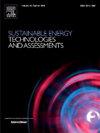Configuration design, heat transfer analysis and performance evaluation of a novel asynchronous stacked electrocaloric refrigeration device
IF 7.1
2区 工程技术
Q1 ENERGY & FUELS
Sustainable Energy Technologies and Assessments
Pub Date : 2025-04-01
DOI:10.1016/j.seta.2025.104300
引用次数: 0
Abstract
Electrocaloric refrigeration, as a sustainable refrigeration technology, remaining numerous challenges in the refrigeration efficiency and/or capacity of the existing reported electrocaloric refrigeration devices. In this study, a novel asynchronous stacked electrocaloric refrigeration device (ASERD) model is firstly proposed. The ASERD model enables simultaneous heat absorption and release within a single refrigeration cycle, thereby maintaining a significant vertical thermal gradient between the upper and lower electrocaloric sliding layers. This creates a “thermal wall” effect that impedes horizontal thermal reflux from the heat dissipation side to the microchip side, reducing the temperature at the microchip side by approximately 5 K compared to synchronous design. Secondly, six typical microchip local dynamic hotspots are designed to verify the ASERD model’s anti-interference ability to heat load fluctuations. During regulation process, the “thermal wall” effect continuously strengthens, resulting in increasing refrigeration performance. The maximum temperature rise is reduced by 9.87 K, 8 K, 9.51 K, 8.92 K, 6.85 K, and 6.98 K, respectively. Thirdly, two main regulation strategies for refrigeration performance enhancement are studied for ASERD model with higher degree of freedom: field intensity and motion frequency. In these two regulation strategies, two overregulated phenomena caused by heat conduction overshoot: temperature feedback and refrigeration reversal phenomenon are discussed in field intensity regulation. Based on above analysis, a hierarchical regulation strategy for refrigeration performance enhancement combining field intensity and motion frequency is proposed, further reducing maximum temperature rise by 10.65 K and 6.96 K compared to optimal single regulation. In summary, the feasibility of ASERD model is verified in principle, which achieves better refrigeration capability compared to conventional synchronous design. Besides, flexible regulation strategy for ASERD model is discussed to further improve the refrigeration performance. Therefore, the novel ASERD model demonstrates better potential application prospects.

一种新型异步堆叠式电热制冷装置的结构设计、传热分析及性能评价
电热制冷作为一种可持续的制冷技术,在现有的电热制冷设备的制冷效率和制冷量方面仍然存在许多挑战。本文首次提出了一种新的异步堆叠式电热制冷装置(ASERD)模型。ASERD模型能够在单个制冷循环内同时吸收和释放热量,从而在上下电热滑动层之间保持显著的垂直热梯度。这产生了“热壁”效应,阻碍了从散热侧向微芯片侧的水平热回流,与同步设计相比,微芯片侧的温度降低了约5 K。其次,设计了6个典型的微芯片局部动态热点,验证ASERD模型对热负荷波动的抗干扰能力。在调节过程中,“热壁”效应不断增强,制冷性能不断提高。最大温升分别降低了9.87 K、8 K、9.51 K、8.92 K、6.85 K和6.98 K。第三,研究了高自由度ASERD模型提高制冷性能的两种主要调节策略:场强和运动频率。在这两种调节策略中,讨论了场强调节中由热传导超调引起的温度反馈和制冷反转两种过调节现象。在此基础上,提出了一种结合场强和运动频率的分层调节策略,与最优单次调节相比,最大温升分别降低了10.65 K和6.96 K。综上所述,原理验证了ASERD模型的可行性,与常规同步设计相比,ASERD模型具有更好的制冷能力。此外,还讨论了ASERD模型的柔性调节策略,以进一步提高制冷性能。因此,新型ASERD模型具有较好的潜在应用前景。
本文章由计算机程序翻译,如有差异,请以英文原文为准。
求助全文
约1分钟内获得全文
求助全文
来源期刊

Sustainable Energy Technologies and Assessments
Energy-Renewable Energy, Sustainability and the Environment
CiteScore
12.70
自引率
12.50%
发文量
1091
期刊介绍:
Encouraging a transition to a sustainable energy future is imperative for our world. Technologies that enable this shift in various sectors like transportation, heating, and power systems are of utmost importance. Sustainable Energy Technologies and Assessments welcomes papers focusing on a range of aspects and levels of technological advancements in energy generation and utilization. The aim is to reduce the negative environmental impact associated with energy production and consumption, spanning from laboratory experiments to real-world applications in the commercial sector.
 求助内容:
求助内容: 应助结果提醒方式:
应助结果提醒方式:


